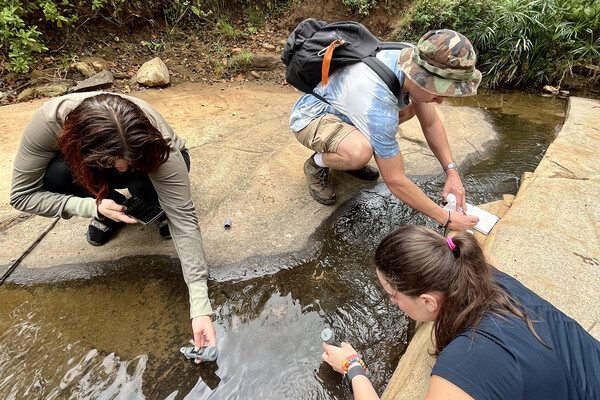
Griffin Pitt, right, works with two other student researchers to test the conductivity, total dissolved solids, salinity, and temperature of water below a sand dam in Kenya.
(Image: Courtesy of Griffin Pitt)
Stacey C. Peeples typically has a sense of what she’s getting into when she receives new materials to process. As curator and lead archivist of Pennsylvania Hospital’s (PAH) historic collections, she often works with defined groups—a set of photographs taken during World War I, for example, or pieces of early-19th-century correspondence between physicians and the Board of Managers.
Sometimes, though, she opens a basic copy paper box that was left on a shelf and finds an unexpected trove of items. Earlier this spring, one such box was tightly packed with an unsigned floral painting, a pamphlet detailing the life of PAH’s first resident, Jacob Ehrenzeller, a collection of fragile newspaper clippings, and much more. Though this hodgepodge didn’t contain any earth-shattering pieces that fundamentally changed Peeples’ understanding of PAH history, it did remind her that even after her 20 years in the archives, there’s always something new to discover.
One of Peeples’ favorite items was a card from 1959 advertising a public auction hosted by PAH and Samuel T. Freeman & Co. Auctioneers—the nation’s first hospital and auction house, respectively. Given that PAH’s expansive historic collections include a fire engine, Benjamin West’s “Christ Healing the Sick in the Temple” painting, over 13,000 volumes in the Historic Medical Library, and more, it’s strange to think that there was a point in the hospital’s history when leaders would choose to give away items.
However, the Board of Managers didn’t really have a choice. In 1957, the 44th and Market mental health facility—built in 1836 and known colloquially as “Kirkbride’s Hospital” in honor of chief physician and mental health advocate Thomas Story Kirkbride—was closed when the city exercised its right of eminent domain to develop the subway. Before the building was demolished, patients were moved to the new, consolidated Institute of Pennsylvania Hospital at 49th and Market streets, and community members were invited to purchase the furniture and furnishings from the original building.
“I’d be very interested to know if there’s anybody who bought items from this auction who still have them, or if pieces were passed down through their family.” Peeples says.
This story is by MaryKate Wust. Read more at Penn Medicine News.
From Penn Medicine News

Griffin Pitt, right, works with two other student researchers to test the conductivity, total dissolved solids, salinity, and temperature of water below a sand dam in Kenya.
(Image: Courtesy of Griffin Pitt)

Image: Andriy Onufriyenko via Getty Images

nocred

Provost John L. Jackson Jr.
nocred